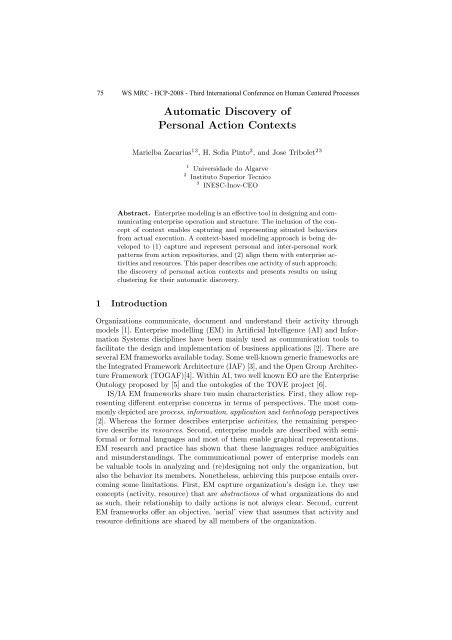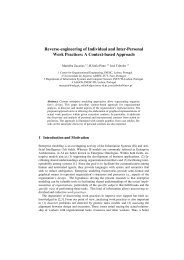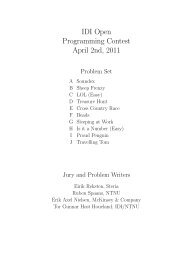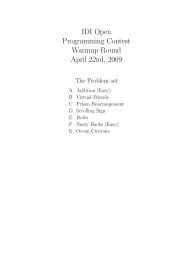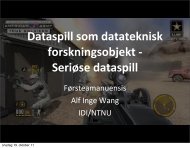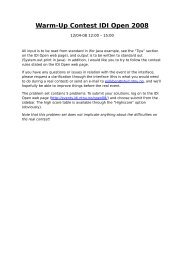Automatic discovery of personal action contexts - CiteSeerX
Automatic discovery of personal action contexts - CiteSeerX
Automatic discovery of personal action contexts - CiteSeerX
You also want an ePaper? Increase the reach of your titles
YUMPU automatically turns print PDFs into web optimized ePapers that Google loves.
76 WS MRC - HCP-2008 - Third International Conference on Human Centered ProcessesThe inclusion <strong>of</strong> the concept <strong>of</strong> context in enterprise models enables situatedrepresentations reflecting the behavior <strong>of</strong> given agents, in specific circumstances,from their particular viewpoints. A conceptual framework composed<strong>of</strong> an (1) architecture and ontology <strong>of</strong> organizational agents and <strong>contexts</strong>, and(2) a context-based methodological approach to build representations based onthe ontology is proposed in [7, 8]. The goal <strong>of</strong> this framework is to enrich EMto capture and represent <strong>personal</strong> and inter-<strong>personal</strong> work patterns from actual<strong>action</strong>s and inter<strong>action</strong>s, and to relate them with enterprise activities andresources. The methodological approach encompasses six activities; bootstrapping,<strong>action</strong> capture, context <strong>discovery</strong>, context analysis and context integration.This paper provides details <strong>of</strong> the context <strong>discovery</strong> activity and presents resultsin applying clustering as a means to support this activity.The remainder <strong>of</strong> this paper is structured as follows; section 2 describesthe fundamental concepts <strong>of</strong> our framework, section 3 summarizes the modelacquisition activities giving more details <strong>of</strong> the context <strong>discovery</strong> activity, section4 describes the usage <strong>of</strong> clustering in the automatic <strong>discovery</strong> <strong>of</strong> <strong>personal</strong> <strong>action</strong><strong>contexts</strong>, section 5 gives our conclusions and future directions.2 A Model Centered on Agents and ContextsFigure 1 shows the fundamental concepts <strong>of</strong> this work, and the relationships betweenthem. In this framework, activities and resources are design-related concepts.Agents, <strong>action</strong>s, roles, and <strong>contexts</strong> are related to execution. Resources arethe entities (things, information or persons) relevant for the organization’s operation.Resources are identified with nouns, and may be simple i.e. single items,or complex i.e. composed <strong>of</strong> several items. Agents are special resources with acting,coordination/management and adaptation capabilities. In our framework,agents may be human, automated or semi-automated, individual or collective.In this work, the concept <strong>of</strong> agent refers only to single individuals.Activities are abstr<strong>action</strong>s <strong>of</strong> what agents do. Activities use resources (inputs)and produce resources (outputs). Activities are related to given organizationalgoals. Activities are specified with procedures i.e. the required steps to accomplishthem. Actions are atomic acts performed by agents to change the state<strong>of</strong> resource-related items. Actions may communicative or non-communicative.Inter<strong>action</strong>s are adjacent pairs <strong>of</strong> communicative <strong>action</strong>s exchanged betweenagents. Activities are accomplished with <strong>action</strong>s. However, due to the abstractnature <strong>of</strong> activities, the relationship between <strong>action</strong>s and activities will dependon the activity definition and a single <strong>action</strong> may be related to several activities.Roles define the observable behaviour <strong>of</strong> agents. The specific role played byagents is determined by a given context. Contexts define situations continuously(re)created by agent <strong>action</strong>s and inter<strong>action</strong>s. Contexts are related to (1) particulartopics, problems, or other work situations, (2) the interacting agents,(3) time-related factors. This notion <strong>of</strong> context draws on human and social sciences[9–11]. In this fields, context is regarded as a fuzzy and dynamic entity
79 WS MRC - HCP-2008 - Third International Conference on Human Centered ProcessesTable depicted in figure 3 shows how the <strong>action</strong> stream <strong>of</strong> the example contextdescribed in section 2, looks like once collected and structured.Object Description| Actionnº Date foll. SubjectActionType ReceiverNestedAction Main resource-related items..supporting Resources(tools, people, information items)... ... ... ... ... ... ... ... ...20 1-Apr 0 Pr<strong>of</strong>. Smith request Alice pay course X e-mail21 1-Apr 20 Alice check Pr<strong>of</strong>. Smith's payment requirements excel, payment requirement records22 1-Apr 21 Alice request Pr<strong>of</strong>. Smith send Pr<strong>of</strong>. Smith's payment requirements e-mail23 1-Apr 22 Alice inform pay will proceed when requirements are sente-mail24 1-Apr 23 Pr<strong>of</strong>. Smith request Alice pay without payment requirements e-mail25 1-Apr 24 Pr<strong>of</strong>. Smith inform Alice reason for not sending requirements26 1-Apr 25 Pr<strong>of</strong>. Smith inform Alice promise requirements for date D e-mail27 2-Apr 26 Alice analyze payment request and reason given28 2-Apr 0 Alice request Boss analyze accept or reject Pr<strong>of</strong>. Smith's request telefone29 2-Apr 28 Alice's boss analyze payment request and reason given30 2-Apr 29 Alice's boss suggest Alice accept payment request <strong>of</strong> Pr<strong>of</strong>. Smith telefone31 2-Apr 30 28 inform Alice pr<strong>of</strong>. Smith is a good pr<strong>of</strong>essor telefone32 2-Apr 27 Alice accept Pr<strong>of</strong>. Smith pay course X e-mail33 2-Apr 32 Alice order Luisa pay course X to Pr<strong>of</strong>. Smith34 2-Apr 33 Alice inform Pr<strong>of</strong>. Smith pay is ordered e-mailFig. 3. Sample Action LogContext <strong>discovery</strong> entails identifying, characterizing, and labeling <strong>personal</strong><strong>action</strong> <strong>contexts</strong>. In this activity, <strong>personal</strong> <strong>contexts</strong> become ’entities’ characterizedby a set <strong>of</strong> keywords. Context visualization displays main context characteristicsto their owners, for validation purposes. In context-based analysis, <strong>personal</strong><strong>contexts</strong> are used as units <strong>of</strong> analysis for several purposes:– Discovering <strong>personal</strong> work and resource usage patterns– Discovering context switching behavior to capture and model human multitaskingat work. Since <strong>personal</strong> <strong>contexts</strong> group together similar <strong>action</strong>s andresources, they provide a good estimation <strong>of</strong> work fragmentation.– Linking inter-related pairs <strong>of</strong> <strong>personal</strong> <strong>contexts</strong> <strong>of</strong> two given individuals allowsto uncover and characterize inter-<strong>personal</strong> <strong>contexts</strong> and further, contextbasedinter<strong>action</strong> networks.– A proper association <strong>of</strong> <strong>action</strong>s with activities and resources require analyzing<strong>action</strong> groupings rather than single <strong>action</strong>s. Hence, the identification andcharacterization <strong>of</strong> <strong>personal</strong> <strong>action</strong> <strong>contexts</strong> allows to relate daily <strong>action</strong>s toorganizational activities and resources.In Context integration, context-based patterns are related to enterprise activitiesand resources. Those considered as good practices, trigger changes in currenttask/resource models. In this paper, we focus the context <strong>discovery</strong> activity. Adetailed description <strong>of</strong> all activities is provided in [8].3.1 Discovering ContextsThe identification <strong>of</strong> <strong>personal</strong> <strong>contexts</strong> entails identifying and labeling <strong>of</strong> meaningful<strong>action</strong> groupings <strong>of</strong> single individual. The context <strong>discovery</strong> and visualizationsactivities involve first, grouping <strong>action</strong> streams involving a similar set <strong>of</strong>
81 WS MRC - HCP-2008 - Third International Conference on Human Centered Processesand previously separated words (verbs), resource related items are embeddedwithin non-structured object descriptions and they may be represented by nounor noun phrases.Identifying time-related keywords. The date(s) when <strong>contexts</strong> are typicallyactive refer to the date interval(s) grouping the greatest number <strong>of</strong> <strong>action</strong>s. Thedefinition <strong>of</strong> this keyword will vary according criteria defined by both the observersand observed subjects. In the example, this keyword reflects the executiondate <strong>of</strong> all <strong>action</strong>s (1-2 Apr). The commitments handled are directly related tothe typical <strong>action</strong>s. Being request, a recurrent <strong>action</strong> within this context, it isinferred that the reply-to-request commitment had to be frequently handled.4 Using Clustering to Discover Personal ContextsClustering is a data mining technique applied to discover groups <strong>of</strong> related dataobjects based on attribute similarity within data sets, without any prior knowledge<strong>of</strong> the group definition [12]. Clustering techniques apply when instances areto be divided in natural groups. These clusters presumably reflect some mechanismat work in the domain from which instances are drawn, causing someinstances to bear a stronger resemblance to one another than with the remaininginstances. Since the clustering underlying mechanisms are rarely known, thechoice <strong>of</strong> clustering approaches is usually dictated by the available tools.There are three main clustering methods; (1) Nearest Neighbor rule knownas K-means, (2) incremental and (3) statistical clustering. Statistical or probabilisticclustering assigns instances to clusters probabilistically. Probabilisticclustering supposes identifying the probability density functions <strong>of</strong> data source.Each distribution governs the attribute values <strong>of</strong> a different cluster. An efficientrepresentation <strong>of</strong> the probability density function is the mixture model, whichasserts that the data is a combination <strong>of</strong> k individual component densities, correspondingto the k clusters [13]. When the class <strong>of</strong> an instance is known, the clusterdistribution gives the probability <strong>of</strong> an instance having a certain attribute valueset. Since data records may belong to all k clusters but with different probability,the mixture model allows overlapping clusters. A well-known implementation <strong>of</strong>the mixture model is the Expectation-Maximization (EM) algorithm [13]. Dueto its probabilistic nature, arbitrary shaped clustering can be effectively representedby the choice <strong>of</strong> suitable component density functions (poisson, sphericalor non-spherical Gaussians for numeric attributes, and binomial or multinomialdistribution for categorical or discrete data).4.1 Case StudyThe usage <strong>of</strong> clustering in discovering <strong>contexts</strong> was tested in a case involvinga s<strong>of</strong>tware development team <strong>of</strong> a commercial bank. The team was integratedby 4 programmers (Gonçalo, Carla, Catarina, Alexandre) and the project leader(Mariana). During the observation, the team worked on applications to manageSuppliers, Claims, Mail, Evictions, andMarketing Campaigns. In this case, a
82 WS MRC - HCP-2008 - Third International Conference on Human Centered Processesthree-week observation was conducted, where over 650 <strong>action</strong>s were collected,and grouped in <strong>personal</strong> <strong>contexts</strong> by the observed subjects. Figure 5 show the<strong>contexts</strong> identified by the subject Carla during the observation period, alongwith its identifying keywords.Ctx Actions Human Resources Information Items Toolsc1 program pedro, mariana common services applicationgoogle, msdn, sqlserver, visual studiodotnetc2answer,discuss, help alexandre, marianamail application, suppliersapplicationmail application, suppliers-app swc3 accept, assistcatarina, mariana,alexandre, goncaloteam meeting, project status,resource distribution plan e-mailFig. 5. Personal Contexts <strong>of</strong> the Subject Carla4.2 Data PreparationThe format <strong>of</strong> the data to be clustered was integrated by a record set withthe following columns: (1) number that reflects the <strong>action</strong> chronological order,(2) day <strong>of</strong> occurrence, (3) agent-sender performing the <strong>action</strong>, or sending acommunicative <strong>action</strong>, (4) agent-receiver <strong>of</strong> the communicative <strong>action</strong>,(5) type<strong>of</strong> the <strong>action</strong> performed, (6) nested <strong>action</strong> embedded in communicative <strong>action</strong>s,(7) description <strong>of</strong> the object <strong>of</strong> the <strong>action</strong>. In the case <strong>of</strong> communicative <strong>action</strong>s,it describes the object <strong>of</strong> the embedded <strong>action</strong> within it, (8) tools applicationalor technological items used in performing <strong>action</strong>s, (9) Information items, (10)human resources used in performing <strong>action</strong>s.This format was well fitted for manual context identification. It enabled avisual appreciation <strong>of</strong> <strong>action</strong> attributes looking at one or two <strong>of</strong> lines. Nonetheless,its reuse for automated means required rethinking not only the attributesto be included, but also their format and the extension <strong>of</strong> their domain, that is,the set <strong>of</strong> values <strong>of</strong> each attribute. One essential step in preparing data was thusto devise means <strong>of</strong> extracting attribute values from free-form textual fields.Attribute Selection: The attributes were selected (1) accordingly to the definition<strong>of</strong> <strong>personal</strong> <strong>contexts</strong> and (2) from the experience acquired from themanual selection process. Three types <strong>of</strong> attributes were selected; <strong>action</strong>, resource,and date-related attributes. Recurrent <strong>action</strong> types form part <strong>of</strong> thecharacteristics <strong>of</strong> <strong>personal</strong> <strong>contexts</strong>. This assumption was demonstrated in themanual process, where in each grouping it was possible to identify a couple <strong>of</strong>predominant <strong>action</strong> types. Thus, the <strong>action</strong> type was selected. Though relevant,the nested <strong>action</strong> was not included due to the high number <strong>of</strong> noncommunicative<strong>action</strong>s, where this field is empty. Since the <strong>action</strong> groupingsare based on resource similarity, all fields containing information related to resourceswere included, whether this information referred to toos, informationor human resources. Hence, the agent-receiver, description, tools and
83 WS MRC - HCP-2008 - Third International Conference on Human Centered Processeshuman resources attributes were selected. The information items attributewas not selected because it was noted in the manual process that the items includedin this column were already present in the description colummn andit was thus, redundant. Finally, the day and number attributes were selectedin order to discriminate clusters with similar <strong>action</strong> types and resources, butperformed in different time intervals and which according to the definition <strong>of</strong><strong>contexts</strong>, may belong to different <strong>contexts</strong>.Keyword Te rmfrequencysuppliers application 192Claims application 105Team meeting 58evictions web service 42Mail application 31Fig. 6. Some recurrent description itemsData cleansing and transformation: A second iteration <strong>of</strong> cleansing andtransformation was accomplished for the attributes selected, using Sql ServerIntegration Services (SSIS) R○. Summarizing, it encompassed the following steps:(1) Worksheet data was transferred to a Sql Server database table. (2) In orderto guarantee consistent and logic attribute value sets, dictionaries were createdfor the receiver, <strong>action</strong>, description, tools and human resource attributes. Thesedictionaries were built using a term extr<strong>action</strong> service to identify recurrent nounsand/or noun phrases from the textual data <strong>of</strong> the corresponding fields, alongwith the frequency <strong>of</strong> each term. The table in figure 6 shows a sample <strong>of</strong> thedictionary created for the description column. (3) The dictionaries created wereanalyzed to detect remaining errors or inconsistencies using a fuzzy groupingservice that applies fuzzy logic to group similar terms. (4) Detected typo errorsand name inconsistencies were removed from the <strong>action</strong> log, using simple database operations. (5) The final description attribute dictionary was analyzed todetermine the most meaningful keywords. This analysis resulted in the selection<strong>of</strong> description terms formed by noun phrases with a frequency ≥ 5.4.3 ModelingThis section summarizes the results <strong>of</strong> the modeling phase. A probabilistic clusteringapproach was selected among other approaches due to (1) the characteristics<strong>of</strong> the problem domain and (2) the mixed nature <strong>of</strong> the attributes.Regarding the problem domain, since <strong>contexts</strong> are regarded as entities with noclear-cut boundaries, accepting the existence <strong>of</strong> overlapping clusters, where a
84 WS MRC - HCP-2008 - Third International Conference on Human Centered Processessingle <strong>action</strong> is associated to several <strong>contexts</strong> with a certain probability, seemsthe more appropriate approach. Regarding the attribute nature, the data set collectedinvolves some numeric attributes. However, most <strong>of</strong> them involve textualdata, for which probability clustering is adequate. The tool use for clusteringwas the Micros<strong>of</strong>t Clustering Algorithm <strong>of</strong> Sql Server Analysis Services R○.The algorithm requires several parameters that includes the clustering method,number <strong>of</strong> clusters to be found and a group <strong>of</strong> tuning parameters. The first parameterwas set for a simple version <strong>of</strong> probabilistic clustering, adequate forsmall data sets. Since the goal is to explore clustering as means for automatingthe <strong>discovery</strong> o <strong>personal</strong> <strong>contexts</strong>, the clustering process was accomplishedseparately for each individual and the cluster count parameter was set to thevalue corresponding to the number <strong>of</strong> <strong>contexts</strong> identified by each individual inthe manual context identification process. For the tuning parameters, defaultvalues were used since the size <strong>of</strong> the data set did not require different values.4.4 Clustering ResultsFigure 7 depicts the cluster diagram for the subject carla, once analyzed andlabelled. The diagram shows three clusters, where cluster ’commonSservicesApplic’is darker because this cluster groups a greater number <strong>of</strong> <strong>action</strong>s than theremaining clusters. The link between clusters ’DevelopmentSupport’ and cluster’TeamMeetings’ indicates that there is a greater similarity between them thanbetween these two clusters than with the former cluster. Understanding theseclusters requires looking at the cluster characteristics, and comparing them withthe keywords <strong>of</strong> manually identified clusters.Carla's ClustersC3C1C2ClusterCharacteristicsFig. 7. Clustering ResultsFigure 7 depicts the top attributes <strong>of</strong> the cluster ’Common Services Application’in decreasing probability. The top characteristics <strong>of</strong> cluster 1 (fig. 7) includethe description item common services application, the <strong>action</strong> program, and thetool terms google, msdn, visual studio dotnet and sqlserver. These characteristicsare very similar to the keywords identified for the <strong>personal</strong> context common
85 WS MRC - HCP-2008 - Third International Conference on Human Centered Processesservices application. This similarity allowed labelling cluster 1 as the ’common-ServicesApp..’ (c1) in figure 5. Likewise, cluster 2 characteristics were similarto the development support context (c2), and cluster 3 to the team meetingscontext.4.5 Evaluating Clustering ResultsThe clustering process was evaluated both qualitative and quantitatively. Thequalitative evaluation involved a visual comparison <strong>of</strong> the characteristics <strong>of</strong> manuallyidentified <strong>contexts</strong> and the clusters produced by the algortithm. As a result,a correspondence matrix relating manual and automatic clusters was built.Whereas in several cases a one-to-one mapping was possible, in others, thismapping could not be established. In order to obtain a more precise accuracymeasure, another comparison matrix was built. In this matrix, the rows identifythe manually identified <strong>contexts</strong> and columns identified the clusters producedby the algorithm for each subject. The cluster with (1) the greatest number <strong>of</strong><strong>action</strong>s belonging to a same manual context, and (2) similar characteristics tothe manual context, was considered as the correct cluster. Actions <strong>of</strong> the samecontext scattered in other clusters were considered as an incorrect classification.Accuracy was estimated adding the number <strong>of</strong> correctly grouped <strong>action</strong>s anddividing them by total number <strong>of</strong> <strong>action</strong>s. Accuracy estimates for each cluster,individual and overall accuracy were calculated. At a cluster level <strong>of</strong> each subject,programming and team meetings <strong>contexts</strong> exhibit more accuracy. This is consistentwith the qualitative evaluation since those <strong>contexts</strong> were identified mosteasily than others. At an individual level, accuracy ranged from 0.89 (Carla) to0.56 (Mariana). Accuracy diminished as the number <strong>of</strong> <strong>contexts</strong> increased. Theoverall accuracy estimate (0.71) indicates that over 70% <strong>of</strong> the total <strong>action</strong>s werecorrectly grouped. Figure 8 depicts the accuracy estimates <strong>of</strong> Carla’s clusters.Context Description Cluster 1 Cluster 2 Cluster 3 Total Context Success RateCommon Services Application Programming 20 1 21 0.95Development Support 8 2 10 0.80Team Meetings 1 11 12 0.92Total Cluster 20 10 13 43 0.89Fig. 8. Carla’s clusters Evaluation Results5 Conclusions and OutlookThis paper describes the results <strong>of</strong> using clustering techniques in the automatic<strong>discovery</strong> <strong>of</strong> <strong>personal</strong> <strong>contexts</strong> from manually captured <strong>action</strong>s. A relevant part
86 WS MRC - HCP-2008 - Third International Conference on Human Centered Processes<strong>of</strong> data preparation was the extr<strong>action</strong> <strong>of</strong> recurrent noun phrases from <strong>action</strong>descriptions, which served as the attribute values <strong>of</strong> the <strong>action</strong> description attribute.As indicated by all case study subjects, <strong>action</strong> descriptions were takeninto account in the manual identification <strong>of</strong> <strong>personal</strong> <strong>contexts</strong>. Hence, includingdescription items as part <strong>of</strong> clustering attributes was essential.A probabilistic clustering algorithm was applied to the <strong>action</strong>s <strong>of</strong> each subject,separately. A qualitative and quantitative evaluation procedure was definedto compare manually identified <strong>contexts</strong> with clusters produced by thealgorithm. Whereas the automatic process produced acceptable starting pointclusters in almost all cases, in the case <strong>of</strong> the team leader (Mariana), who handleda greater number <strong>of</strong> <strong>contexts</strong>, clustering quality requires further improvement.Cluster quality can be improved (1) including automatic capture mechanismsthat would reduce data inconsistency and errors, (2) determining attribute dependencies,and (3) determining attribute degree <strong>of</strong> relevance for context detection.It is noteworthy that some manual groupings are too fine-grained, regardingthe number <strong>of</strong> <strong>action</strong>s registered. Moreover, some groupings obey to user knowledgenot explicit in <strong>action</strong> data and thus, cannot be found through automatedtechniques. Hence, a successful usage <strong>of</strong> this technique in supporting contextidentification requires taking into account their limitations.Currently, the benefits <strong>of</strong> our approach have been validated in small casestudies. Automated support for all activities is required in order to employ it inwider settings and during longer periods. We are researching in proper means <strong>of</strong>automating <strong>action</strong> capture, as well as context <strong>discovery</strong> and analysis activities.Action capture prototypes are being tested in real settings.The present workrepresents a first effort in automating the context <strong>discovery</strong> activity. The selection<strong>of</strong> the clustering method and tool was motivated by the importance <strong>of</strong> usingtechnologies readily available for enterprises. Nonetheless, other means need tobe explored, in order to determine their advantages and inconveniences.References1. Caetano, A., Silva, A., Tribolet, J.: Object-oriented business process modeling withroles. In: 7th International Conference on Information Systems ImplementationModeling. (2004)2. Shekkerman, J.: How to Survive in the Jungle <strong>of</strong> Enterprise Architecture Frameworks.Trafford (2004)3. Cap Gemini.: The Integrated Architecture Framework IAFhttp://www.capgemini.com/services/soa/ent architecture/iaf/ (2007)4. Open Group.: The Open Group architectural framework (TOGAF) - version 8.1http://www.opengroup.org/architecture/togaf8-doc/arch/ (2003)5. Uschold, M., King. M., Moralee, S., Zorgios, Y.: The Enterprise Ontology In:Knowledge Engineering Review, 13(1) (1998) 31–896. Fox, M.S.: The TOVE Ontology Project http://www.eil.utoronto.ca/enterprisemodelling/tove/index.html(2002)7. Zacarias, M., Magalhães, R., Caetano, A., Pinto, H., Tribolet, J.: Towards OrganizationalSelf-Awareness: An Initial Architecture and Ontology. In: Ontologies forBusiness Inter<strong>action</strong>s. IDEA Group (2008) 101–120
87 WS MRC - HCP-2008 - Third International Conference on Human Centered Processes8. Zacarias, M., Serendero, P., Pinto, H.S., Tribolet, J.: Capturing and modeling workpractice: A context-based approach. Revue d’Intelligence Artificialle (In Press)9. Kokinov, B.: A dynamic approach to context modeling. In Brezillon, P., Abu-Hakima, S., eds.: Working Notes <strong>of</strong> the IJCAI’95 Workshop on Modelling Contextin Knowledge Representation and Working Notes <strong>of</strong> the IJCAI’95 Workshop onModelling Context in Knowledge Representation and Reasoning. (1995) 59–7210. Latour, B.: Reassembling the Social : An Introduction to Actor-Network. OxfordUniversity Press (2005)11. Engeström, Y., Miettinen, R., Punamäki, R.: Perspectives on Activity Theory.Cambridge University Press, Cambridge MA, USA (2005)12. Witten, I.H., Frank, E.: Data Mining. Morgan Kaufmann Publishers (2000)13. Bradley, P., Fayyad, U., Reina, C.: Scaling EM (expectation - maximization)clustering to large databases. Technical Report MSR-TR-98-35, Micros<strong>of</strong>t Research(1999)


